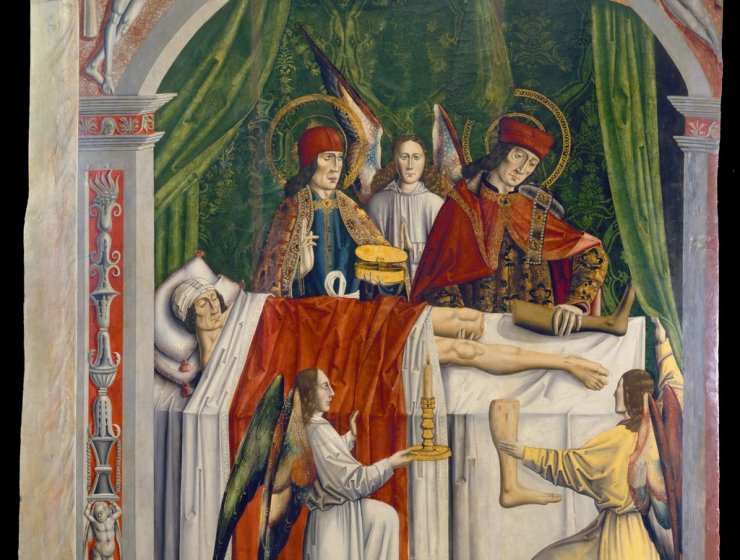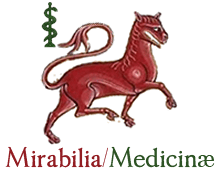
-Index-
Life Stories in Medicine
Hélio ANGOTTI NETO
Original title: Histórias de Vida na Medicina
This volume of Mirabilia / Medicinæ Journal brings three articles on Medical Humanities, History of Medicine and Medical Education. The first article is the academic report of the 5th UNESC Seminar on Medical Humanities - Life Stories in Medicine -, held on June 9 and 10, 2017 at Campus I of the University Center of Espírito Santo, in Colatina, Espírito Santo. The second article covers the history of Alois Alzheimer (1864-1915 AD). And the last article describes a health education initiative in the context of patient safety, an area of great importance and prominence in healthcare.
V UNESC Seminar of Medical Humanities
Renylena Schmidt LOPES, Victor Hugo de Castro e SILVA, Hélio ANGOTTI NETO
Original title: V Seminário UNESC de Humanidades Médicas
On June 9 and 10, 2017, the V UNESC Seminar of Medical Humanities was held. It is a pioneering event created in 2013 to discuss topics including: Bioethics, Medical Philosophy, Medical History, Medical-Patient Relationship, Medical Ethics and Literature. This edition of the event was called "Life Stories in Medicine", and was divided into three blocks: (a) Humanization in Healthcare, addressing patients' life histories; (b) Professionalism and Ethics, addressing the life histories of healthcare professionals; and (c) Bioethics – The Abortion Debate, with different views on the lives of doctors, mothers and future generations.
A Disease Called Alzheimer
Daniel Pinheiro HERNANDEZ, José Guilherme Pinheiro PIRES, Mayara BUENO, Pedro Henrique Martins de OLIVEIRA, Rafael Vinícius Lôndero Quintino dos SANTOS
Original title: Uma Doença Chamada Alzheimer
Alzheimer's disease is the most common type of dementia. Its onset is insidious, and the brain damage is continuous, resulting, over time, in the functional disability of the patients. The objective of this paper is to know the history of the discovery of Alzheimer's Disease and to understand the origin of this eponym. The study was carried out through bibliographic research in the following databases: Pubmed, Scielo and Lilacs. The following descriptors were used: Alois Alzheimer, History of Medicine, Alzheimer's Disease. Alois Alzheimer was born in the small town of Marktbreit in Bavaria (Germany), and graduated in 1887 receiving his medical degree from the University of Würzburg. He took up his first position as an assistant at the Asylum for Mental and Epileptic Patients in Frankfurt, where he served for 14 years. He met Franz Nissl (1860-1919), the German neuropathologist, and together they studied the cortex of patients with pre-senile dementia. He presented his postdoctoral thesis showing the existence of neurofibrillary entanglements, which came to characterize a specific form of dementia. In 1910, the German psychiatrist Emil Kraepelin (1856-1926) named this condition as Alzheimer's Disease. Alzheimer is recognized as a memorable psychiatrist and neuropathologist who discovered a disease that today affects millions of people worldwide.
Patient Safety: distance learning as a teaching-learning strategy
Rosana ALVES, Ana Claudia Camargo Gonçalves GERMANI, Francis Solange Vieira TOURINHO, Siulmara Cristina GALERA, Andréa Aparecida CONTINI, Sandra Rosa Sponchiado GASPARINI, Gustavo Salata ROMÃO
Original title: Segurança do Paciente: educação à distância como estratégia de ensino-aprendizagem
The World Health Organization (WHO) estimates that care-related assistance errors determine damage affecting thousands of individuals around the world. The error leads to permanent damage or even death; and also leads to an increase in hospitalization time and also to financial costs (WHO, 2008) 1. A number of measures have been taken, based on the report " To Err is Human: building a safer health system" (19992), which referred to errors related to health care assistance. In Brazil, the National Agency of Sanitary Surveillance - ANVISA (2011) 3 reinforces the objective of avoiding harm to patients, and considers the error as a human condition, being an opportunity to get to know, learn and prevent errors in health services. In this direction, the Patient Safety has been widely discussed among professional health classes and also in the scientific environment, however there are gaps between the translation of knowledge to the practice of health professionals. The objectives were to raise awareness among teachers of the health professions on the issue of Patient Safety, to disseminate knowledge about the subject, to present and discuss the National Patient Safety Program (NPSP), through a Distance Learning Course (DLC) using the Moodle Platform. The DLC course was set up in three blocks and course evaluation. Teachers in the health area of several College Education Institutions were the target audience. Each block, with an average of 10 days, provided scientific articles and videos as material for consultation. Each block also presented a task followed by collective or individual feedback. The participant can contribute at any time, even after the deadline established. The 1st Block presented a video of the World Health Organization on "Patient Safety", the task being the discussion in the Forum. The 2nd Block was based on the analysis of photos of patient's risk situations. Finally, the 3rd Block requested the proper application of the Clinical Simulation to its course reality, considering the goals of the NPSP. On average, 35 teachers (from a target audience of 50) took part in all course activities. The Content analysis, according to Bardin, of the posts in the Block 1 from the Forum, demonstrated teachers' facilities and difficulties in promoting Patient Safety in their daily activities. In Block 2, was realized the questionnaire of the photos analysis. The feedback counted with the correct responses based on the NPSP (where most detected the error) and a consolidated response of participants. In Block 3, the video analysis about simulation and participation in the forum reinforced the importance of implementing activities or scenarios of simulated practice where the teaching-learning process in Patient Safety could be addressed, with aspects focused on the application of the NPSP. We consider that we have achieved the previously established objectives, since: 1) it was possible to present and discuss the NPSP; 2) there was a stimulus to the reflexive process on the applicability of the Patient Safety guidelines through photographic analysis; 3) the application of the knowledge to each participant's work environment was encouraged.


















































































